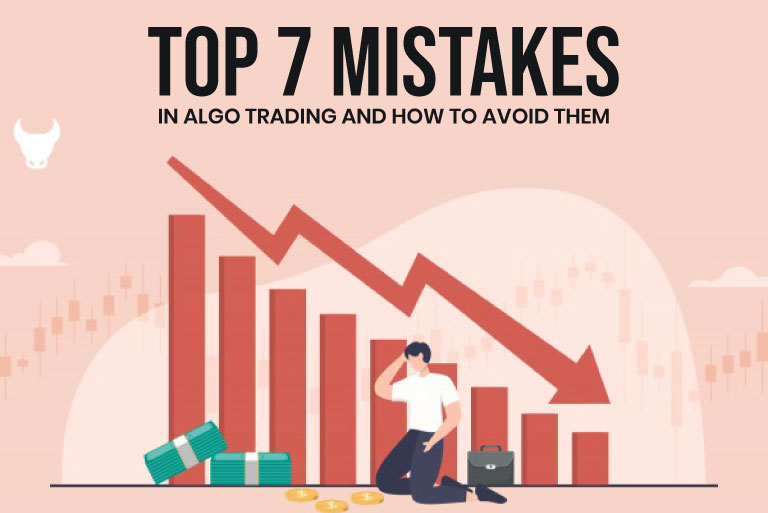What is Algo Trading and Why It’s Popular
Algo trading, short for algorithmic trading, is the use of computer programs to execute trades based on predefined strategies. It eliminates emotional decision-making, allows high-speed executions, and opens the door for backtesting complex strategies.
In India, algo trading is growing rapidly among retail and institutional traders due to its speed, accuracy, and data-driven approach. However, despite its benefits, many traders suffer losses—not because algo trading doesn’t work, but because they make crucial mistakes.
Avoiding these common mistakes in algo trading can mean the difference between consistent profits and significant losses.
1. Poor Risk Management
Many traders focus solely on building profitable strategies, forgetting the cornerstone of successful trading—risk management.
Why It’s a Mistake
Ignoring stop-loss mechanisms or overexposing capital to a single trade can wipe out gains quickly. Algo trading systems may execute multiple trades rapidly, and without checks in place, a single bug or wrong input can lead to massive losses.
How to Avoid It
- Implement stop-loss and trailing stop logic in your code.
- Use proper position sizing to diversify risk.
- Set daily loss limits to protect your portfolio.
A well-coded risk management layer in your algo strategy can save you from market unpredictability.
2. Over-Optimization or Curve Fitting
This is one of the most common mistakes in algo trading especially among beginners who rely heavily on backtest results.
Why It’s a Mistake
Over-optimization happens when traders adjust parameters excessively to fit historical data, making strategies look perfect in the past but unreliable in real-time trading.
How to Avoid It
- Use out-of-sample data to test your strategy’s robustness.
- Avoid using too many indicators or parameters.
- Focus on logic that works across different timeframes and market conditions.
Simplicity often beats complexity in real-world markets
3. Ignoring Market Conditions
Algo strategies that work in a bull market might fail miserably during high volatility or bearish phases.
Why It’s a Mistake
Market regimes change frequently. Algo strategies must be adaptable to survive in different environments. A static strategy can result in repeated losses if it doesn’t account for volatility or macro changes.
How to Avoid It
- Include volatility filters in your strategy.
- Use technical indicators that signal regime shifts (e.g., ATR, VIX).
- Monitor macroeconomic data that can affect the market.
Adaptability is key to longevity in algorithmic trading.
4. Lack of Real-time Monitoring
Many traders believe once the algo is live, their job is done. This is one of the most dangerous misconceptions.
Why It’s a Mistake
Glitches, slippage, or unexpected market behavior can cause your strategy to act unpredictably. Without real-time monitoring, errors can escalate.
How to Avoid It
- Always monitor live trades using dashboards or trade logs.
- Set alerts for unusual behavior (e.g., multiple order failures).
- Have a manual override or kill switch in place.
Even the best algorithm needs human supervision.
5. Not Considering Transaction Costs
Beginners often overlook transaction costs, assuming their net profit is what the backtest shows. This is far from reality.
Why It’s a Mistake
Brokerage fees, slippage, taxes, and other charges can turn a seemingly profitable strategy into a losing one—especially for high-frequency traders.
How to Avoid It
- Include slippage, fees, and taxes in your backtest model.
- Opt for brokers with API support and competitive pricing.
- Trade instruments with high liquidity to reduce impact costs.
Always trade with net profitability in mind.
6. Blindly Using Third-party Strategies
Some traders rely on pre-built algorithms or signal providers without fully understanding how they work.
Why It’s a Mistake
If you don’t know the logic behind your trading system, you can’t fix it when things go wrong. You also risk depending on strategies that might be outdated or overexposed.
How to Avoid It
- Learn the basics of how algo trading works.
- Customize third-party strategies to suit your risk appetite.
- Perform your own backtests and validations.
Owning your strategy gives you confidence and control.
7. Neglecting Regulatory Compliance
In India, SEBI has laid down specific guidelines for algo trading. Failing to comply with them can result in penalties or even blacklisting.
Why It’s a Mistake
Not only is it illegal to deploy certain types of algos without approvals, but regulators are also increasingly monitoring unauthorized trading activity.
How to Avoid It
- Always use SEBI-approved brokers and platforms.
- Avoid using misleading or manipulative trading practices.
- Stay updated with SEBI’s algo trading rules and circulars.
Compliance is not optional—it’s critical.
Contact Us for Algo Trading
Conclusion: Trade Smart with Awareness
Algo trading can be a powerful wealth-building tool—but only if done right. The above mistakes in algo trading are easy to make but equally easy to avoid with discipline, knowledge, and proper strategy design.
Always prioritize understanding, testing, monitoring, and compliance over speed or automation. Remember, in algorithmic trading, it’s not about trading more—it’s about trading right.
FAQ
Have questions? We’ve answered some of the most common queries to help you understand the topic better
Q1. What is the biggest mistake in algo trading?
The biggest mistake is poor risk management—trading without stop-loss or limits can quickly lead to major losses.
Q2. Can I use someone else’s algo strategy safely?
Yes, but only after fully understanding it and customizing it to your capital, risk tolerance, and goals.
Q3. How often should I update my algo strategy?
You should review your strategy monthly or when there’s a significant market shift or regulatory change.
Q4. Are transaction costs really that important?
Absolutely. Ignoring brokerage, slippage, and taxes can turn a seemingly profitable strategy into a loss-making one.
Q5. Is algo trading legal in India?
Yes, but it must follow SEBI regulations. Using unauthorized or manipulative algorithms is illegal.
Let's Automate Growth
Rapid Algo Ai, India’s leading algorithmic trading and copy trading automation platform — empowering traders, investors, and institutions with fast, reliable, and intelligent trading solutions.
